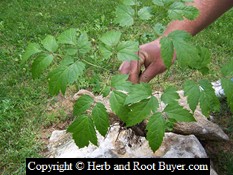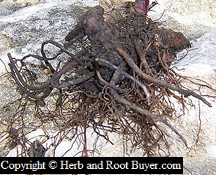Black Cohosh – Cimicifuga racemosa
|
Current Demand = GOOD |
Parts Used: Root |
Common Names: black cohosh, black snakeroot, macrotys, bugbane, bugwort, rattleroot, rattleweed…
Description:
The leaves are large with 3 pinnately compound divisions and irregular toothed leaflets. Tall plumes of white to cream flowers are located on waif/wand like stems. The flowering season runs from May to July. During the fall, seeds develop in capsules that make a rattling sound when shaken. At this stage they are mature and ready for harvest.
For clarification, root will refer to the rhizomes and root combined. The root is of economic value. When the leaves of the plant start to die, the root is ready for harvest and drying.
Growing region: Black cohosh can be found in the Eastern United States and Southeastern Canada. It is common thru-out the Appalachian mountain region. Black cohosh can be found from the Carolinas west to Iowa, south to Arkansas and north to Minnesota. Large populations of black cohosh are found in West Virginia, Kentucky, Ohio, Virginia and Tennessee. It is often found in rich moist hardwood forests. It grows well out of direct sunlight and is often found along timber trails and shady ravines.
Harvesting/ Drying
Harvesting happens in the fall when the plant leaves start to die. Late season harvesting will allow the plant to seed. That is also the time when the root is at peak weight and peak bioactive constituents. Digging should be done by hand or at best a spading fork. Gather the larger more mature plants leaving plenty of younger smaller plants to seed the area for future harvest.
Shake the roots free of soil and carefully separate out any roots that are not black cohosh. Protect the root from the sun and be sure all loose soil, rocks and other foreign material are removed. If the root is to be used for planting stock they must be immediately placed in moist soil and stored in a burlap bag, cardboard box or mesh bags in a cooler with a temperature in the 40 degree Fahrenheit. Be sure the roots do not dry out and keep the roots aerated by stirring; this also prevents mildew from forming.
If the roots are to be sold for processing, wash them carefully with a pressure water hose or a root washer. A common root washer consists of a rotating drum with water nozzles positioned to spray the roots as they tumble. It is vital that all soil and sand be removed from the roots. Large roots may need to be broken in half or chopped into smaller two to three inch pieces to aid in drying. Black cohosh can be dried in the sun although when possible dry indoors in a well ventilated barn loft or attic to protect from the outdoor elements. Drying on screens works well. If natural heat is not available, you may need to add heat and a fan for continuous airflow. Remember a cut root will bring more money than a dirty root.
The key to drying any root, herb or bark in an even combination of heat and airflow. Never use an oven or microwave.
The Black cohosh will be completely dry (largest stem will snap not bend) in 5-10 days depending on the size of the root and the drying conditions. Place the herb carefully into a cardboard box or paper bag for storage in a dry area until you are ready to sell or use. Do not store the roots in plastic or it will mold. Always allow plenty of time for your crop to dry for maximum value.
Dry at a low heat with a high air flow. A herb dryer is preferred, but a food dehydrator, a small room outfitted with a dehumidifier, a fan and a heater can be used. There are several different temperature regimes for drying but the most common and easiest is to stay at 80-95 degrees Fahrenheit for several days to a week. When you can snap the root it is dry. Once the roots are completely dried, they should be stored in burlap bags, cardboard drums or light-proof poly sacks in a cool, dark and dry location. The dry-down rate for black cohosh is about 1/3 of its fresh weight. In a good year one acre can yield 2,500 lbs of dried root. Do not keep the roots for longer than one year.
Planting
Prefers a moist humus soil and some shade and grows well in dappled shade and ordinary garden soil. Plants are hardy to -20 degree Celsius. Regardless of the cultivation system it’s important to have a site with well-drained, but moist soil. Raised beds are highly recommended especially for clay soils and soils that stay wet after a heavy rain. Make sure sufficient compost and or organic material is added to raise the organic matter content of the soil.
The rows should be 4-5 feet apart and the plants should be 18-24 inches apart. The holes should be 6-8 inches, deep enough to cover the top of the rhizome with two inches of soil. Make sure at least one bud is attached to each plant. Cover the beds with at least three inches of shaved tree bark mulch or leaf mulch. Add mulch as needed throughout the life of the planting. Roots should be ready for harvest in three to five years after planting.
 Root Buyer
Root Buyer

